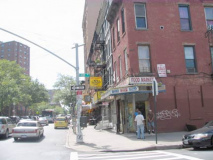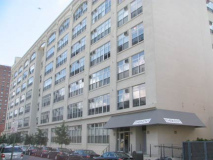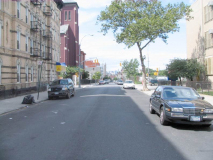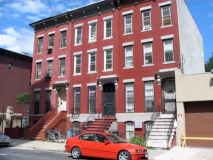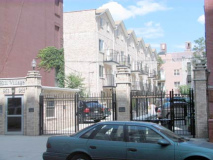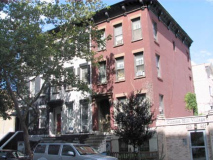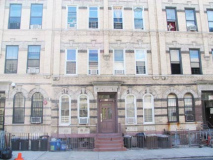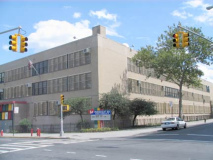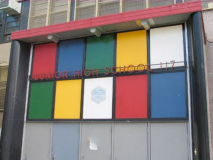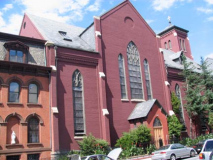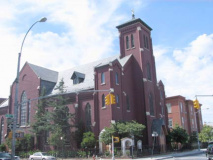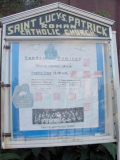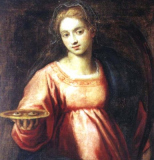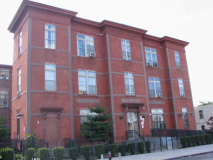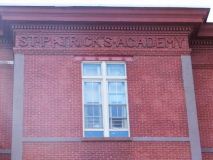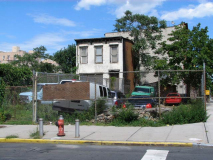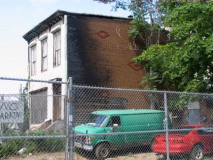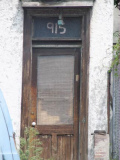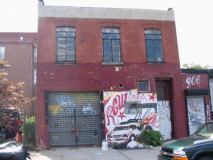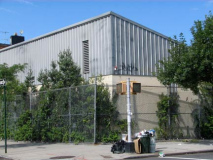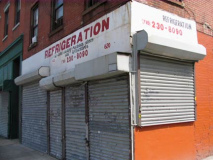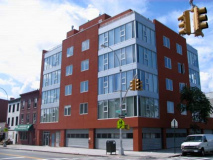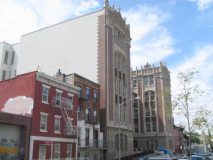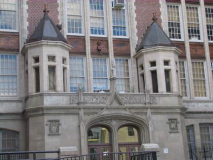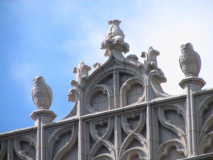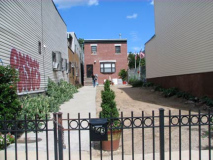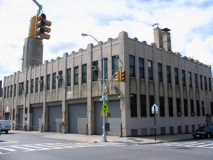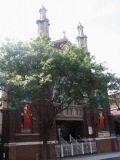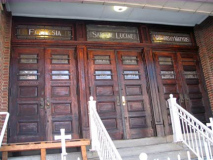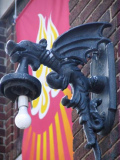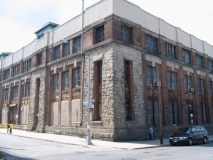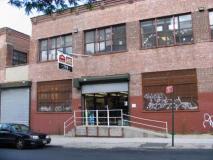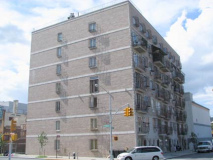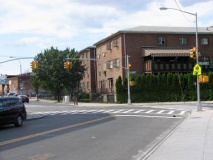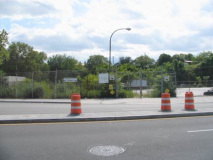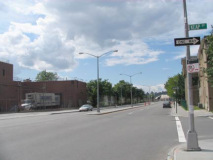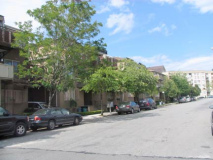Kent Avenue runs from the eastern end of Clinton Hill to the Williamsburg-Greenpoint border. Because of Brooklyn’s topography along the Brooklyn Navy Yard, Wallabout Channel and the East River, the route resembles a giant question mark in reverse without the dot. It’s unusual among Williamsburg’s north-south avenues like Wythe Avenue, Berry Street, and Driggs Avenue in that it continues well south of Division Avenue, where those avenues end, and plunges well south to the Clinton Hill-Bedford Stuyvesant border. (Bedford Avenue, which I’m in the middle of surveying as well, is Brooklyn’s longest, matching Kent’s curved route as far south as Wallabout Street — from thence it runs in almost a straight line south to Sheepshead Bay). Your webmaster has traversed Kent Avenue many times for different purposes since the 1970s, and I thought I’d snapshot the ever-changing avenue as it was in 2008…
Kent Avenue, according to Brooklyn By Name aficionados Leonard Benardo and Jennifer Weiss, is named for the first law professor at Columbia College, James Kent (1763-1847). “Kent’s Commentaries on American Law (4 vols., 1826-30), the product of his celebrated Columbia lectures, mark the onset of modern legal scholarship.”
Though Kent Avenue “begins” where its street numbering begins in Williamsburg, I have chosen to begin here in Clinton Hill where it “ends” and work my way north. The southern section of Kent Avenue, between Lafayette and Division Avenues, was called Kent Avenue first, with the section north of that was named First Street: Williamsburg’s north-south streets were numbered until 1880 or so — Kent Avenue, being closest to the East River, was First Street; Wythe, Second; Berry, Third, and so on.
So, Kent Avenue’s southern limit is at DeKalb Avenue and the Lafayette Gardens Houses (before they were built Kent Avenue extended south to Lafayette). A small cluster of groceries and bodegas serve the housing project here. The drug gang “Cash Money Brothers” operated here well into the supposedly crime-lessened mid-2000s. The imaginatively-named “The Kent,” 970 Kent, is a doorman building that features luxury condos in a formerly industrial loft building (an underwear factory, so I have heard).
One-tree hill. Kent Avenue, between DeKalb and Willoughby Avenues. Manhattan, and the slanting Citicorp Tower, are in the background.
…are separated by some fresh krapp: Clinton Hill Village, a gated cul-de-sacked cluster of Fedderzation at 963-965. To be fair, the interiors don’t look all that bad. Units have been selling for between $455-$670,000.
945 Kent, one of an interesting row of blond brick apartment building with arched windows on the ground floor.
At Willoughby, I liked the Rubik’s Cube motif on the entrance of the Francis Scott Key School, JHS 117.
There are exactly 43,252,003,274,489,856,000 possibilities, which is approximately forty-three ?quintillion. The puzzle is often advertised as having only “?billions” of positions, as the larger numbers could be regarded as incomprehensible to many. To put this into perspective, if every permutation of a 57-?millimeter Rubik’s Cube were lined up end to end, it would stretch out approximately 261 ?light years. Alternatively, if laid out on the ground, this is enough to cover the earth with Rubik’s cubes 275 thick. wikipedia Like sudoku, Rubik’s is insolvable for your webmaster, but some can solve it in under 10 seconds. There is a method.
Francis Scott Key (1779-1843) was an attorney and was the lyricist of the national anthem, the Star-Spangled Banner; he wrote it while witnessing an 1814 bombardment at Fort McHenry in Maryland during the War of 1812. He was an attorney by trade and in 1832 served as solicitor for Sam Houston, then an ex-Governor of Tennessee, after a fight in which he caned US Representative William Stanbery of Ohio. (Houston was found guilty but merely reprimanded. Later fined $500 when the case was brought to civil court, he refused to pay it and left the USA for the Republic of Texas). As for Key, he was a distant cousin of novelist F. Scott Fitzgerald, whose full name was Francis Scott Key Fitzgerald.
On the SW corner of Willoughby and Kent Avenues we find the red-bricked Romanesque Church of St. Lucy-St. Patrick (with a hyphen and not an “and” between.)
The building combines the parishes of St. Patrick, founded in 1848 (named St. Mary until 1856) and St. Lucy, founded 1904. The two churches catered to Irish and Italian congregations respectively. Brooklyn Genealogy has an item about the early days of St. Patrick’s parish:
“Back in the early [eighteen] forties there was an old public roadhouse on the Newtown Road, now Flushing Ave, kept by a Mrs. Mackey, an Irish Catholic. In the coffee-room of this tavern the need of a Catholic church in the growing district of the Wallabout was frequently discussed. Encouraged by the splendid results which had followed the erection of the Church of St Mary’s in the neighboring village of Williamsburgh, the Catholics of the Wallabout section resolved to have a place of Divine worship of their own.
“At that time there stood an old Methodist Church on Kent Ave., near Myrtle. Negotiations were entered into and the Church with two lots was finally purchased by the Catholics for three thousand dollars. This was the humble beginning of what is now one of the largest and best equipped parishes in the city.
In 1843 Bishop Hughes appointed the first pastor, the Reverend Hugh Maguire. The construction of the present church began in 1848, and was dedicated on August 17th, 1856 by Bishop McLoughlin.
St. Patrick has a large parish of his own in Bay Ridge. We will later encounter a second church of St. Lucy on Kent Avenue; it formerly belonged to the Roman Catholic parish of St. Lucy, which decided to combine with this St. Patrick’s parish in 1974 for financial considerations. St. Lucy is usually depicted as a beautiful woman holding a pair of eyeballs on a dish or a chalice. According to Church biographies, she was a 4th-century martyr who was tortured and killed by the Roman Emperor Diocletian who had her eyes put out; her sight was miraculously restored: she is patron saint for those with eye trouble. Her name comes from the Latin term for “light.” Diocletian, meanwhile, is regarded as one of the more successful Roman emperors after Christ’s birth.
The parish school, St. Patrick’s Academy, is nearby, the sign on the facade giving a clue about the original name of the parish. It is a handsome red-brick building dating from the looks of things to the 1890-1915 period.
The building on the NW corner of Willoughby and Kent, 915 Kent, is a mystery: a small, two story building on a large plot. As you can see the front door has not been touched since 1940 or so.
The house may be a reminder of the 19th Century when some small farms may have still been in the area.
906 Kent. Possibly a former stable
NE corner Myrtle and Kent. “Concrete and soils lab,” Department of Environmental Protection
New and old Brooklyn, Myrtle and Kent. Storefront, SE corner, and new building, probably a mix of commercial and residential, NW corner.
850 Kent, PS 157, Benjamin Franklin School, Gothic Revival constructed about 1907, designed in an H shape by architect C.P. H. Gilbert. 40 terracotta owls are standing gauard on the parapets.
“There is not a dark corner in the whole structure.” –Jacob Riis
The school was rehabilitated in 2000-2001 by Swanke Hayden Connell Architects
Long lawn, little house, across Kent Avenue from PS157
Likely a former factory, Park and Kent Avenues. Park Avenue, shrouded by the BQE for half its length, used to have both an elevated line and a cable car line. Both were in the dim past — each torn down/removed by 1891.
The Other St. Lucy’s
Kent Avenue features a “second” St. Lucy’s, a St. Lucy’s Cathedral; this was the ‘original’ parish church of St. Lucy that combined parishes with St. Patrick on Willoughby Avenue in 1974.
Since that year this building has come under the auspices of the Old Roman Catholic Church of North America, a separate entity from the Church of Rome. The ORCC was founded by Bishop Arnold Harris Mathew, a suspended British Catholic priest, in 1908; he founded the ORCC apparently as an alternative to both the Church of Rome and earlier sects such as the Old Catholic Church and the Utrecht Union as well as the Church of England. Because the ORCC resisted the tenet of papal infallibility to a degree (the OCC and Utrecht Union reject it completely), Mathew was subsequently excommunicated by Pope Pius X. In 1914, Mathew charged Bishop Rudolph Francis Edward Hamilton de Lorraine-Brabant with establishing the ORCC ministry in North America.
The ORCCNA’s Father Steve Tyminski’s blog provides insights on this little-known alternative to the Church of Rome.
I was intrigued by the lamp fixtures flanking the church entrance. I thought I recognized the somewhat vermiform reptile with the spiny webbed wings. Then it hit me: it was Reptilicus, the Danish entry into the giant dinosaur monster movie mania of the late 50s and early 1960s.
Japan had its Godzilla (and several pals like Ghidrah and Rodan), England had its Gorgo, but it took until 1961 for American International Pictures and Sid Pink (Of Angry Red Planet fame) to join forces with Saga Studios of Denmark for the first Danish monster to appear. Reptilicus wasn’t played by the traditional man in a suit but by a puppet (strings are visible in some scenes) — Reptilicus apparently took the form of a traditional heraldic dragon, with a long body, four small claws (he preferred to travel on his belly, like a snake) and wings; a flying scene was prepared but not used. The movie begins with a scene not for the squeamish as some miners discover some bloody flesh in the ground at Lapland; taken to a lab, the ‘tail’ regenerates into Reptilicus, who goes on a rampage in Copenhagen…
I’ve always been fascinated by this massive, brick and stone building that occupies the block bordered by Kent Avenue, Taaffe Place, Little Nassau Street and Flushing Avenue. A former armory, perhaps? Looks like a bomb couldn’t annoy this place. Little Nassau Street is a one-block alley south of Flushing Avenue, which is the eastern extension of downtown’s Nassau Street, approximately 20 blocks to the west; more logically the street should be called “Little Flushing Avenue.”
A tip from ForgottenFan Mike Epstein to a NYTimes article reveals the building was constructed in 1904-05 for $370,000 as a combined stable and administration building for the Department of Sanitation, then the Department of Street Cleaning.
795 Kent, left, and Fedders special, Flushing and Kent Avenues. Quite a number of cheaply made multifamily houses that resemble houses of detention have appeared in the Flushing Avenue vicinity in southwern Williamsburg of late. For some neighborhoods, this building is the future of Brooklyn architecture.
Flushing Avenue runs approximately seven miles between downtown Brooklyn and Maspeth, Queens, which puts it nowhere near Flushing, Queens. However, in its previous incarnation as the Brooklyn and Newtown Turnpike, it led to a maze of roads that led to northern Queens’ largest town, and a close look at the map will show them still there.
Today, to get to Flushing using Flushing Avenue, your best bet is to follow it to its junction with Grand Avenue in Maspeth, follow the Long Island/Horace Harding Expressway service road at 69th Street, then the LIE itself to Exit 22 (College Point Boulevard) north to Sanford, east to Main, and there you are. If you want to use just the local streets most of the way, follow the Q58 bus route: Grand Avenue, Broadway, Corona Avenue, 108th Street, LIE service road, College Point Boulevard.
At Wallabout Street, Kent Avenue enters Williamsburgh and begins its great curve along Wallabout Channel and the East River, first northwest and then northeast. Like Flushing Avenue (which is nothing more than an English-language mishmash of the Dutch town of Vlissingen) Wallabout Street is a similar bowdlerization, this time of the Dutch Waal-boght, or “bay of the Walloons,” the Walloons being French speaking people in Holland.Both names ar reminders of Dutch rule in NYC, which encompassed the years 1624-1664.
Here Kent Avenue begins a long stretch adjoining the Brooklyn Navy Yard. Directly beyond the fence here can be spotted Steiner Studios, a 15-acre film and television production facility, which opened in 2004.
Promises to Keap
Streets that intersect with Kent Avenue here are named for signers of the Declaration of Independence, the famed and not-as-famed; Rutledge, Penn, Hewes, Hooper, Ross, Wilson… and then there’s Keap, which isn’t named for anyone, really, but is a complete mistake. A long-ago administrator or mapmaker mistook a handwritten transcription of Thomas McKean of Pennsylvania as being “Thomas M. Keap”, and misnamed the street, which has never been renamed.
In high school, our bowling team had its matches at a fleabitten, cigarette-butt flicked lanes on Moultrie and Humboldt Streets in Greenpoint, and to get from our school in Bedford-Stuyvesant to Greenpoint, the route of choice (when we weren’t schlepping our bowling bags on the G train, where a kid once cracked my skull into a subway train wall and fled onto the platform before I could do anything about it) in our Dodge Ram van, was Kent Avenue. In the Super 70s, this stretch of the avenue was a sea of red brick paving.


